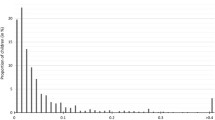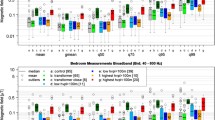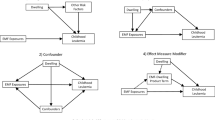Abstract
Objectives: To evaluate the risk of childhood leukemia in relation to residential electric and magnetic field (EMF) exposures.
Methods: A case control study based on 88 cases and 133 controls used different assessment methods to determine EMF exposure in the child's current residence. Cases comprised incident leukemias diagnosed at 0–14 years of age between 1985–1993 from a larger study in southern Ontario; population controls were individually matched to the cases by age and sex. Exposure was measured by a personal monitoring device worn by the child during usual activities at home, by point-in-time measurements in three rooms and according to wire code assigned to the child's residence.
Results: An association between magnetic field exposures as measured with the personal monitor and increased risk of leukemia was observed. The risk was more pronounced for those children diagnosed at less than 6 years of age and those with acute lymphoblastic leukemia. Risk estimates associated with magnetic fields tended to increase after adjusting for power consumption and potential confounders with significant odds ratios (OR) (OR: 4.5, 95% confidence interval (CI): 1.3–15.9) observed for exposures 0.14 microTesla (μT). For the most part point-in-time measurements of magnetic fields were associated with non-significant elevations in risk which were generally compatible with previous research. Residential proximity to power lines having a high current configuration was not associated with increased risk of leukemia. Exposures to electric fields as measured by personal monitoring were associated with a decreased leukemia risk.
Conclusions: The findings relating to magnetic field exposures directly measured by personal monitoring support an association with the risk of childhood leukemia. As exposure assessment is refined, the possible role of magnetic fields in the etiology of childhood leukemia becomes more evident.
Similar content being viewed by others
References
Wertheimer N, Leeper E (1979) Electrical wiring and childhood cancer. Am J Epidemiol 109: 273-284.
Committee on the Possible Effects of Electromagnetic Fields on Biological Systems (1996) Possible Health Effects of Exposure to Residential Electric and Magnetic Fields. National Academy Press.
Delpizzo V, Salzberg MR, Farish SJ (1991) The use of 'spot' measurements in epidemiological studies of the health effects of magnetic field exposure. Int J Epidemiol 20: 448-455.
Theriault G, Goldberg M, Miller AB, et al. (1994) Cancer risks associated with occupational exposure to magnetic fields among electric utility workers in Ontario and Quebec, Canada and France: 1970–1989. Am J Epidemiol 139: 550-572.
Kleinerman RA, Linet MS, Hatch EE, et al. (1997) Magnetic field exposure assessment in a case-control study of childhood leukemia. Epidemiology 8: 575-583.
Dockerty JD, Elwood JM, Skegg DCG, Herbison GP (1998) Electromagnetic field exposures and childhood cancers in New Zealand. Cancer Causes Control 9: 299-309.
Pediatric Oncology Group of Ontario (1992) Summaries of the POGO Registry and Database. Ontario: POGO.
London SJ, Thomas DC, Bowman JD, et al. (1991) Exposure to residential electric and magnetic fields and risk of childhood leukemia. Am J Epidemiol 9: 923-937.
Barnes F, Wachtel H, Savitz D, Fuller J (1989) Use of wiring configuration and wiring codes for estimating externally generated electric and magnetic fields. Bioelectromagnetics 10: 13-21.
Kaune WT, Savitz DA (1994) Simplification of the Wertheimer-Leeper wire code. Bioelectromagnetics 15: 275-282.
Hosmer DW, Lemeshow S (1989) Applied Logistic Regression. New York: Wiley.
Stata Statistical Software: Release 5.0 (1997) Stata Corporation, Stata Press.
Linet MS, Hatch EE, Kleinerman RA, et al. (1997) Residential exposure to magnetic fields and acute lymphoblastic leukemia in children. N Engl J Med 337: 1-7.
Savitz DA, Wachtel H, Barnes FA, John EM, Tvrdik JG (1988) Case-control study of childhood cancer and exposure to 60-Hz magnetic fields. Am J Epidemiol 128: 21-38.
Coghill RW, Steward J, Philips A (1996) Extra low frequency electric and magnetic fields in the bedplace of children diagnosed with leukaemia: a case-control study. Eur J Cancer Prev 5: 153-158.
Miller AB, To T, Agnew DA, Wall C, Green LM (1996) Leukemia following occupational exposure to 60-Hz electric and magnetic fields among Ontario electric utility workers. Am J Epidemiol 144: 150-160.
Author information
Authors and Affiliations
Rights and permissions
About this article
Cite this article
Green, L.M., Miller, A.B., Agnew, D.A. et al. Childhood leukemia and personal monitoring of residential exposures to electric and magnetic fields in Ontario, Canada. Cancer Causes Control 10, 233–243 (1999). https://doi.org/10.1023/A:1008919408855
Issue Date:
DOI: https://doi.org/10.1023/A:1008919408855




